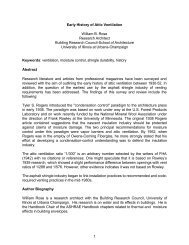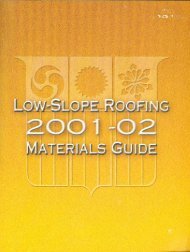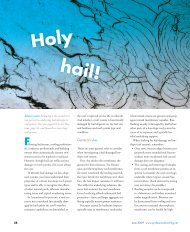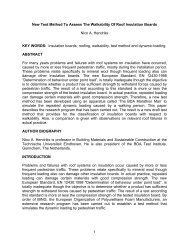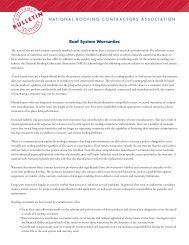1 Self-Adhesive Roofing Felts: Mass Production or Made to Measure ...
1 Self-Adhesive Roofing Felts: Mass Production or Made to Measure ...
1 Self-Adhesive Roofing Felts: Mass Production or Made to Measure ...
You also want an ePaper? Increase the reach of your titles
YUMPU automatically turns print PDFs into web optimized ePapers that Google loves.
<strong>Self</strong>-<strong>Adhesive</strong> <strong>Roofing</strong> <strong>Felts</strong>: <strong>Mass</strong> <strong>Production</strong> <strong>or</strong> <strong>Made</strong> <strong>to</strong> <strong>Measure</strong><br />
By E.A.T. Trommelen, D. Bodt and R. Q. Kluttz<br />
KRATON Polymers Research B.V.<br />
Badhuisweg 3, 1031 CM Amsterdam<br />
The Netherlands<br />
Key W<strong>or</strong>ds: <strong>Roofing</strong>, SBS modified bitumen, adhesive strength, tack<br />
Abstract<br />
In the roofing industry, modified bitumen membranes are generally applied by t<strong>or</strong>ching<br />
with an open flame <strong>or</strong> mopping with hot bitumen <strong>or</strong> asphalt and cold adhesive. These<br />
methods can ensure a strong and watertight seam of overlapping membranes.<br />
However, mopping creates health and od<strong>or</strong> concerns while t<strong>or</strong>ching carries the risk of<br />
fire. Use of cold-applied, solvent-based adhesives is growing rapidly but there are still<br />
limitations associated with volatile <strong>or</strong>ganic compound (VOC) issues and longer curing<br />
times than t<strong>or</strong>ched <strong>or</strong> mopped systems.<br />
A growing demand f<strong>or</strong> self-adhesive roof membranes, driven in part by insurance<br />
companies and legislation <strong>to</strong> increase the safety of the installation w<strong>or</strong>kers, stimulates<br />
the development of suitable f<strong>or</strong>mulations <strong>to</strong> improve the quality and expand the scope of<br />
these products.<br />
Although there are regional differences, premium self-adhesive roofing compounds are<br />
generally composed of multiple ingredients: bitumen/asphalt, a mixture of SBS and SIS<br />
block copolymers, SB di-block polymer, tackifying resin, naphthenic oil, oxidised<br />
bitumen and filler. The mix of included ingredients is determined partly by the<br />
requirements f<strong>or</strong> the final product. However, most imp<strong>or</strong>tantly, this is strongly influenced<br />
by the kind of bitumen <strong>or</strong> asphalt that is used. In addition <strong>to</strong> the same high-temperature<br />
perf<strong>or</strong>mance requirements of conventional membranes, self-adhesive compounds have<br />
the additional requirement of being tacky at the lowest application temperature. This<br />
m<strong>or</strong>e stringent requirement of perf<strong>or</strong>mance over a wide temperature range usually<br />
necessitates m<strong>or</strong>e complex f<strong>or</strong>mulations.<br />
The three most imp<strong>or</strong>tant characteristics required in self-adhesive compounds are: flow<br />
resistance, low temperature tack and resistance <strong>to</strong> disbonding. The first two are<br />
primarily rheology requirements while the latter is characterised by adhesive and<br />
cohesive strength. Rheological models exist f<strong>or</strong> standard nonbituminous compounds,<br />
but with asphalt being the maj<strong>or</strong> component, the models no longer apply. Recent<br />
developments are focused on simplifying the composition of the compound and thereby<br />
easing the manufacture of the self-adhesive compound. Experimental isoprene- and<br />
butadiene-based block copolymers <strong>to</strong> be used as single polymers have been<br />
developed. They balance the various requirements f<strong>or</strong> self-adhesive roofing felts.<br />
Although the production may be simplified by the use of a single polymer combining<br />
sufficient viscous and elastic behaviour in a single SBS <strong>or</strong> SIS block copolymer<br />
1
dedicated f<strong>or</strong> this application, fine tuning may still be required depending on the nature<br />
of the bitumen/asphalt composition.<br />
Auth<strong>or</strong> biography<br />
Erik A.T. Trommelen – February 4, 1963<br />
After graduating (Chemical Engineer) in 1986, I was employed by ‘Shell Expl<strong>or</strong>ation and<br />
<strong>Production</strong>’ f<strong>or</strong> 2 years, modelling oil recovery profiles. After this period I was employed<br />
by ‘Shell KRATON Elas<strong>to</strong>mers’ at the ‘Royal Shell Lab<strong>or</strong>at<strong>or</strong>y Amsterdam’. In the first<br />
assignment the focus was on process engineering issues f<strong>or</strong> the manufacture of<br />
KRATON D (SBS, SIS) polymers in the European production facilities. A second<br />
assignment focused on the start-up of the KRATON G (SEBS, SEPS) polymer<br />
production facility in Berre, France. After study Management Accounting a new role was<br />
taken up in KRATON Polymers. In my current assignment I am responsible f<strong>or</strong> R&D<br />
programmes and Technical Supp<strong>or</strong>t f<strong>or</strong> KRATON Polymers in bitumen f<strong>or</strong> industrial<br />
applications in EU/AF/ME. Member of the BWA (Bitumen Waterproofing Association) -<br />
Technical Committee (Europe).<br />
1. Introduction<br />
Mainly driven by health, safety and environmental (HSE) reasons, insurance companies<br />
and auth<strong>or</strong>ities promote the use of self-adhesive, bituminous roofing membranes that<br />
can be applied without t<strong>or</strong>ching, hot bitumen <strong>or</strong> solvent-based cold adhesives.<br />
An adhesive may be defined as a material which, when applied <strong>to</strong> surfaces of materials,<br />
can join them <strong>to</strong>gether and resist separation. The term adhesion is used when referring<br />
<strong>to</strong> the attraction between the surfaces. The four main mechanisms of adhesion - the<br />
various intrinsic f<strong>or</strong>ces that may operate across the adhesive/substrate interface - are<br />
considered <strong>to</strong> be: mechanical interlocking, diffusion, electron transfer and ads<strong>or</strong>ption. 1,2<br />
It is evident that, depending on the circumstances, any of the four main mechanisms of<br />
adhesion may be responsible f<strong>or</strong> the intrinsic adhesion which enables an interface <strong>to</strong><br />
resist separation under the influence of an applied stress. Analogous <strong>to</strong> pressuresensitive<br />
adhesives (polymer, resin and oil), the relevant mechanisms f<strong>or</strong> a selfadhesive<br />
roofing felt would be: inter-diffusion of polymer chains across the interface<br />
[polymer entanglement, which requires that the adhesive and substrate are mutually<br />
soluble [compatible] and the macromolecules <strong>or</strong> chain segments have sufficient<br />
mobility], as well as intera<strong>to</strong>mic and intermolecular f<strong>or</strong>ces between the surfaces of the<br />
adhesive and substrate (van der Waals f<strong>or</strong>ces).<br />
The three most imp<strong>or</strong>tant characteristics required in self-adhesive compounds are: flow<br />
resistance, low temperature tack and resistance <strong>to</strong> disbonding. The first two are<br />
primarily rheology requirements while the latter is characterised by adhesive and<br />
cohesive strength. One challenge is <strong>to</strong> satisfy these conflicting requirements of the<br />
visco-elastic compound. Rheological models have been developed f<strong>or</strong> nonbituminous<br />
compounds. However, even if complying with the rheological models, the perf<strong>or</strong>mance<br />
2
of bituminous compounds may not fulfil the requirements, and additives may have <strong>to</strong> be<br />
used <strong>to</strong> obtain the desired final properties.<br />
Although there are regional differences, premium self-adhesive roofing compounds are<br />
generally composed of multiple ingredients: bitumen/asphalt, a mixture of SBS and SIS<br />
block copolymers, SB di-block polymer, tackifying resin, naphthenic oil, oxidised<br />
bitumen and filler. The mix of included ingredients is determined partly by the<br />
requirements f<strong>or</strong> the final product. However, most imp<strong>or</strong>tantly, this is strongly influenced<br />
by the kind of bitumen <strong>or</strong> asphalt that is used. In addition <strong>to</strong> the same high-temperature<br />
perf<strong>or</strong>mance requirements of conventional membranes, self-adhesive compounds have<br />
the additional requirement of being tacky at the lowest application temperature. This<br />
m<strong>or</strong>e stringent requirement of perf<strong>or</strong>mance over a wide temperature range usually<br />
necessitates m<strong>or</strong>e complex f<strong>or</strong>mulations.<br />
Recent developments are focused on simplifying the composition of the compound and<br />
thereby easing the manufacture of the self-adhesive compound. In this paper, the<br />
influence of the various ingredients is described and the development of new,<br />
experimental styrene-butadiene- and styrene-isoprene-based block copolymers <strong>to</strong> be<br />
used as single polymers in this application are highlighted.<br />
2. Experimental<br />
To scrutinise the influence of multiple ingredients on the rheological and adhesive<br />
properties of a self-adhesive compound, the following compositional effects have been<br />
examined:<br />
• Influence of type of polymer (mixtures)<br />
Evaluations were carried out in a 200 pen reference bitumen (approximately AC3 <strong>or</strong><br />
PG 52) comprising compounds with a standard radial SBS, high-vinyl radial SBS 1 ,<br />
linear SIS, SB di-block and mixtures thereof. Polymer [A] and Polymer [B] are used<br />
as single polymers <strong>to</strong> achieve the desired properties.<br />
Polymer [A] and Polymer [B] are experimental isoprene and butadiene- based<br />
styrenic block co-polymers (SBC), respectively, especially designed f<strong>or</strong> self-adhesive<br />
applications.<br />
• Influence of tackifying resin<br />
The effect of the addition of a tackifying resin <strong>to</strong> compounds f<strong>or</strong> self-adhesion was<br />
determined. A modified aliphatic resin commonly used f<strong>or</strong> these applications was<br />
added <strong>to</strong> the compounds.<br />
1 ) High-vinyl (1,2-butadiene) Styrenic block co-polymers are available from KRATON Polymers under<br />
the trademark “IPD”. F<strong>or</strong> reasons of simplicity, the grade is referred <strong>to</strong> as IPD in this document.<br />
3
• Influence of bitumen<br />
Various commercially available types of asphalt/bitumen were used <strong>to</strong> produce selfadhesive<br />
compounds. The influence of the bitumen (composition) on the rheological<br />
and adhesive properties of various blends was determined.<br />
2.1 Polymer modified blends<br />
Blends were made with a Silverson L4R high shear mixer. The bitumen was heated <strong>to</strong><br />
160°C and subsequently the polymer(s) and/<strong>or</strong> other additives were added. Upon<br />
blending, the temperature increased <strong>to</strong> 180°C caused by the energy input from the<br />
mixer. Blending at this temperature was continued until a homogeneous blend was<br />
obtained, as determined by flu<strong>or</strong>escence microscopy.<br />
2.2 Specimens f<strong>or</strong> adhesion testing<br />
The roofing sheets f<strong>or</strong> adhesion testing (T-Peel ASTM D1876-93) were prepared by<br />
pouring 55 grams of the compound in a 230 mm by 160 mm by 1.5 mm spacer and<br />
covering it with a polyester carrier. Covered with silicon paper, the sample was placed in<br />
a hydraulic press and pressed f<strong>or</strong> five minutes with a load of 15,000 pounds at 140°C.<br />
After a cooling period of 10 minutes, a second spacer was placed on the other side of<br />
the carrier and filled with an additional 55 grams of compound. Pressing again created<br />
an artificial roofing sheet 3 mm thick. The roofing sheet created was cut from its<br />
spacers. Specimens f<strong>or</strong> T-peel testing measuring 25 mm by 200 mm were cut from the<br />
sheet.<br />
2.3 Test methods<br />
A standard evaluation on the blends was carried out - the determination of the<br />
penetration at 25°C, softening point, viscosity, DIN flow resistance and cold bend. 3<br />
T-peel testing: The adhesive perf<strong>or</strong>mance of a f<strong>or</strong>mulation f<strong>or</strong> self-adhesion was<br />
determined by welding two membranes of equal composition and subsequently<br />
separating them in a T-geometry with a tensile tester. The f<strong>or</strong>ce (N/25 mm) necessary<br />
<strong>to</strong> separate the membranes is a measure of the adhesive bond strength.<br />
The adhesive bond strength of the various compounds was determined at 5°C and<br />
21°C. Conditioning at 5°C was achieved by placing the membranes in a refrigerat<strong>or</strong> f<strong>or</strong><br />
at least 12 hours and welding immediately when taken from the refrigerat<strong>or</strong>, followed by<br />
immediate T-peel testing. Specimens welded at ambient temperature were st<strong>or</strong>ed f<strong>or</strong> at<br />
least 12 hours bef<strong>or</strong>e peel testing. The welding at both temperatures was established by<br />
rolling a 1.0 kg weight 10 times over the membranes. Adhesion was prevented over a<br />
length of 50 mm by covering the ends of the membranes with silicon paper.<br />
T-peel tests were carried out with an Instron 4501 tensile tester. The free ends were<br />
clamped in the grips and then separated at a constant rate of displacement of 254<br />
mm/min acc<strong>or</strong>ding <strong>to</strong> ASTM D1876-93. 4<br />
Tack of the membranes is an imp<strong>or</strong>tant product parameter f<strong>or</strong> quick bonding, especially<br />
at low welding temperatures (
SARA (Saturates Aromatics Resins Asphaltenes) analysis determines in broad<br />
sense the chemical composition of the bitumen. With the SARA method, the<br />
asphaltenes present in the bitumen were first separated from the maltenes by<br />
precipitation in n-heptane. Subsequently, the asphaltenes content was determined<br />
gravimetrically. The resins, aromatics and saturates remaining in the maltenes fraction<br />
were separated and quantified by means of High Pressure Liquid Chroma<strong>to</strong>graphy<br />
(HPLC). 5<br />
3. Results<br />
3.1 <strong>Adhesive</strong> perf<strong>or</strong>mance of commercial felts<br />
In Figure 1 a limited overview is given of the adhesive perf<strong>or</strong>mance of multiple<br />
commercially available roofing felts f<strong>or</strong> self-adhesive application. The adhesive<br />
properties are specified by the T-peel strength of the welded membranes as conditioned<br />
and determined at the two temperatures.<br />
Although the substrate of each membrane is its own self-adhesive compound, the tests<br />
were carried out similarly f<strong>or</strong> each product, resulting in a representative comparison.<br />
Obviously, the differences in adhesive perf<strong>or</strong>mance found f<strong>or</strong> the commercial coatings<br />
are apparent. However, it must be noted that products with excellent adhesive<br />
properties do not necessarily excel in high temperature flow resistance. Although selfadhesive<br />
roofing felts often are composed of standard felts used <strong>to</strong> provide the flow<br />
resistance and are coated completely <strong>or</strong> partially with a thin layer of an adhesive<br />
coating, the adhesive should also have resistance <strong>to</strong> flow when applied on inclined roof<br />
surfaces.<br />
160<br />
140<br />
5°C<br />
21°C<br />
T-Peel strength [N/25mm]<br />
120<br />
100<br />
80<br />
60<br />
40<br />
20<br />
0<br />
A<br />
'97<br />
A<br />
'00<br />
B<br />
'97<br />
B<br />
'00<br />
C<br />
'97<br />
D<br />
'97<br />
D<br />
'00<br />
E<br />
'00<br />
Year<br />
Figure 1. <strong>Adhesive</strong> perf<strong>or</strong>mance of commercially available self-adhesive roofing felts.<br />
F<br />
'97<br />
F'<br />
00<br />
G<br />
'97<br />
G<br />
'99<br />
H<br />
'99<br />
H<br />
'00<br />
I<br />
'99<br />
J<br />
'99<br />
5
3.2 Polymer ingredients f<strong>or</strong> <strong>Self</strong>-<strong>Adhesive</strong> Membranes<br />
As noted in the introduction, compounds <strong>or</strong> coatings f<strong>or</strong> premium self-adhesive products<br />
can be relatively complex. They typically require m<strong>or</strong>e ingredients than a standard<br />
bituminous compound f<strong>or</strong> modified bitumen membranes. Each of these ingredients<br />
plays an imp<strong>or</strong>tant role in combining the required perf<strong>or</strong>mance characteristics. The<br />
challenge is <strong>to</strong> simultaneously obtain sufficient resistance <strong>to</strong> high temperatures<br />
(nonflow) and sufficient viscous behavi<strong>or</strong> and mobility of molecules <strong>to</strong> create<br />
entanglements at low temperatures (flow) in one compound.<br />
Styrenic Block Co-polymers (SBCs) can play a vital role in enhancing the desired<br />
properties. Currently a variety of different SBS, SIS and SB polymers in linear, radial<br />
and full sequential architectures are produced, as presented in Figure 2.<br />
Coupling, n >2 Coupling, n =2 Full sequential Sequential RI Coupling, n >2<br />
Figure 2. Type of Styrenic Block Co-polymers commercially available f<strong>or</strong> self-adhesive<br />
applications.<br />
The required properties set f<strong>or</strong> a self-adhesive membrane compound is similar <strong>to</strong> that of<br />
a pressure-sensitive adhesive (PSA). The same f<strong>or</strong>mulation strategy can be used <strong>to</strong><br />
obtain desired properties. F<strong>or</strong>mulations f<strong>or</strong> PSAs are usually well-defined. 6 Their<br />
adhesive and processing properties are determined not only by the SBCs’ types but<br />
also by the nature and concentration of the various ingredients, such as tackifying<br />
resins, and by their interaction with the two-phase structure of the polymer. Components<br />
such as resins will n<strong>or</strong>mally concentrate in one phase of the polymer, the mid-block <strong>or</strong><br />
the end-block. Mid-block compatible resins modify the low temperature glass transition<br />
temperature (Tg) and modulus. End-block compatible resins modify the high<br />
temperature Tg and flow resistance. Decreasing the elastic modulus is in this case the<br />
route <strong>to</strong> adhesion. In other w<strong>or</strong>ds: provide a compatible environment and soften the<br />
compound.<br />
3.3 Balancing adhesion and rheological properties<br />
A coating f<strong>or</strong> self-adhesion should have both good tack and adhesive strength so one<br />
can “put it down and f<strong>or</strong>get it”, especially at lower temperatures. However, the SBCs<br />
available that provide these properties are by nature smaller molecules that provide<br />
insufficient flow resistance f<strong>or</strong> typical roofing applications.<br />
6
To obtain a better understanding of the possibilities with SBCs’ in bitumen f<strong>or</strong> coatings<br />
f<strong>or</strong> self-adhesive, evaluations were carried out in the 200 pen reference bitumen. These<br />
evaluations show the influence of the types of polymers and mixtures thereof on the<br />
adhesive and rheological properties, i.e. softening point R&B, DIN flow resistance and<br />
cold bend. The results are presented in Figure 3.<br />
140<br />
5°C 21°C R&B [°C] Flow [°C] CB [°C]<br />
T-Peel [N/25mm] <strong>or</strong> T in [°C]<br />
120<br />
100<br />
80<br />
60<br />
40<br />
20<br />
0<br />
-20<br />
-40<br />
SBS IPD SIS<br />
Ingredients<br />
IPD<br />
SIS<br />
IPD<br />
SIS<br />
SB<br />
IPD<br />
SIS / SB<br />
Resin / Oil<br />
Figure 3. <strong>Adhesive</strong> and rheological properties of SBC modified asphalt (200 pen).<br />
In this pragmatic approach, butadiene based SBCs’, SBS and IPD typically used in<br />
roofing application only provide good rheological properties; the adhesive strength is<br />
rather po<strong>or</strong>, especially at low temperatures.<br />
A typical SIS polymer gives excellent adhesion at low temperature. However, a flow<br />
resistance of 50°C is not sufficient f<strong>or</strong> adequate perf<strong>or</strong>mance.<br />
Mixing SBS and SIS <strong>to</strong> combine the desired adhesion and rheological properties is a<br />
logical step. Indeed a better balance is obtained, however, in this case the adhesive<br />
strength at low temperatures has not significantly improved. Addition of SB di-block<br />
reduces the flow resistance and slightly improves the adhesion at low temperature.<br />
The addition of naphthenic oil and tackifying resin increases adhesion f<strong>or</strong> reasons<br />
described below. F<strong>or</strong> this specific f<strong>or</strong>mulation a good balance in properties is obtained.<br />
Unf<strong>or</strong>tunately, six different ingredients are required, which complicates production<br />
safety.<br />
7
3.4 Effect of tackifying resin<br />
Resins are commonly used ingredients in compounds f<strong>or</strong> self-adhesives. There is a<br />
wide variety of commercially available resins, aliphatic and aromatic, that modify SBC<br />
mid-block, end-block <strong>or</strong> both, and in that sense consequent f<strong>or</strong>mulating principles apply.<br />
Unf<strong>or</strong>tunately, the presence of asphalt frustrates those principles and expertise had <strong>to</strong><br />
be built.<br />
In a bituminous adhesive coating, such a resin should essentially improve compatibility<br />
of SBC and asphalt and change the mid-block Tg, allowing the adhesive strength <strong>to</strong><br />
improve. Resins manufacturers in cooperation with the roofing industry have found that<br />
optimum improvement is obtained with resins compatible with both blocks. The latter is<br />
indeed the case as is presented in Table 1. However, including a resin in an adhesive<br />
compound also affects other typical properties.<br />
In this example, a modified-aliphatic resin with a Tg of 43°C was used, giving a ring and<br />
ball softening point of 97°C. The T-peel strength is improved with the addition of the<br />
resin <strong>to</strong> this specific compound; however, at low temperatures no improvement was<br />
observed. Furtherm<strong>or</strong>e, it is clear from Table 1 that an optimum in resin content needs<br />
<strong>to</strong> be determined.<br />
The Tg of the resin influences the cold bend of the <strong>to</strong>tal compound negatively. Although<br />
the softening point of the compound gradually decreases with increasing resin content,<br />
because of the softening of the polystyrene domains by the resin, the flow resistance is<br />
maintained at 95°C.<br />
Blend no. 1 2 3 4<br />
Polymer IPD IPD IPD IPD<br />
Polymer SIS SIS SIS SIS<br />
Bitumen PX-200 PX-200 PX-200 PX-200<br />
Resin, %wt 0 5 10 15<br />
Pen at 25°C, dmm 65 53 45 40<br />
R&B, °C 119 118 115 113<br />
Viscosity at 180°C<br />
20 s -1 , Pa.s 2.7 3.1 3.0 3.3<br />
100 s -1 , Pa.s 2.6 3.0 2.9 3.2<br />
Cold bend, pass °C -30 -25 -25 -20<br />
DIN Flow, pass °C 95 95 95 95<br />
T-peel at 5°C, N 8 1 1 4<br />
T-peel at 21°C, N 55 80 98 99<br />
Table 1.<br />
Effect of tackifying resin (content) on typical perf<strong>or</strong>mance.<br />
3.5 Developments in polymers f<strong>or</strong> self-adhesive applications<br />
Investigations intended <strong>to</strong> simplify the production of self-adhesive roofing compounds<br />
have led <strong>to</strong> the development of experimental polymers f<strong>or</strong> this specific application - a<br />
single polymer <strong>to</strong> replace the multiple ingredients f<strong>or</strong> a premium compound f<strong>or</strong> self-<br />
8
adhesive application. The ultimate challenge is <strong>to</strong> combine sufficient cohesive and<br />
adhesive properties in the final product by balancing viscous and elastic properties at<br />
the right temperature in one polymer.<br />
This w<strong>or</strong>k resulted in polymer [A], an isoprene-based SBC, and polymer [B], a<br />
butadiene-based SBC. The results are presented in Figure 4, and the result of the<br />
mixture of components is also given f<strong>or</strong> comparison reasons. The adhesive<br />
perf<strong>or</strong>mances presented represents commercial felts as described in Figure 1.<br />
With the single polymer [A] in bitumen, a satisfact<strong>or</strong>y balance is obtained between the<br />
adhesive properties and typical rheological perf<strong>or</strong>mance. The results observed easily<br />
match those of the compound with the multiple ingredients. However, with a single<br />
polymer the manufacturing process is greatly simplified.<br />
With the single experimental butadiene SBC polymer [B] in bitumen, the low<br />
temperature adhesive perf<strong>or</strong>mance might be considered insufficient. This directly<br />
demonstrates the difference between butadiene and isoprene in a SBC f<strong>or</strong> adhesive<br />
purposes. Isoprene is intrinsically softer than butadiene and theref<strong>or</strong>e better suited f<strong>or</strong><br />
adhesive applications.<br />
140<br />
120<br />
5°C 21°C R&B [°C] Flow [°C] CB [°C]<br />
T-Peel [N/25mm] <strong>or</strong> T in °C<br />
100<br />
80<br />
60<br />
40<br />
20<br />
0<br />
-20<br />
-40<br />
B '97 D ’00 J '99 IPD<br />
SIS / SB<br />
Pol [A] Pol [B]<br />
Resin / Oil<br />
Year commercial membrane<br />
Ingredients<br />
Figure 4. Perf<strong>or</strong>mance of single polymers [A] and [B] in 200 pen reference bitumen.<br />
3.6 Influence of asphalt in compounds f<strong>or</strong> self-adhesive<br />
As already mentioned in section 3.2, compounds f<strong>or</strong> pressure-sensitive adhesives are<br />
mixtures of well-defined components. The primary component in a compound f<strong>or</strong> selfadhesive<br />
roofing felts is the bitumen <strong>or</strong> asphalt. Although the components of the asphalt<br />
9
can roughly be divided in<strong>to</strong> saturates, aromatics, resins and asphaltenes (SARA), it is<br />
still a mixture of multiple molecules of various length, polarity and structure, depending<br />
in composition and consistency on the crude oil processing of the oil used. There are<br />
<strong>to</strong>o many uncertain parameters <strong>to</strong> call it a well-defined ingredient in terms of<br />
composition.<br />
An indication of the effect of the asphalt on the quality of a self-adhesive compound is<br />
shown in Table 2. The results show the adhesive properties, T-peel strength and tack of<br />
polymer [A] in various commercially available types of asphalt. Furtherm<strong>or</strong>e, SARAanalysis<br />
was carried out on the bitumens <strong>to</strong> obtain an indication of the composition.<br />
Bitumen A B C D E<br />
Pen at 25°C, dmm 190 145 234 174 176<br />
R&B, °C 39 43 40 42 41<br />
Asphaltenes, %wt 6.0 9.0 6.8 11.2 7.9<br />
Saturates, %wt 5.7 14.0 11.7 10.5 10.1<br />
Aromatics, %wt 66.5 58.9 67.1 59.4 63.9<br />
Resins, %wt 21.8 18.1 14.5 18.9 18.2<br />
T-peel at 5°C, N 42 1 27 31 1<br />
T-peel at 21°C, N 86 77 81 48 73<br />
Tack at 5°C very good no very good good no<br />
Tack at 21°C very good po<strong>or</strong> very good very good po<strong>or</strong><br />
Table 2.<br />
Influence of asphalt on adhesive perf<strong>or</strong>mance – Polymer [A] inc<strong>or</strong>p<strong>or</strong>ated<br />
The effect of the asphalt on the tack and T-peel strength at low temperature is manifest.<br />
Unf<strong>or</strong>tunately, the ratio and content of the components of the asphalt do not explain <strong>or</strong><br />
clarify the differences found. There is no clear relationship between the asphaltene<br />
content <strong>or</strong> aromaticity and the adhesive properties of the blends with the various types<br />
of bitumen.<br />
However, it must be noted that the results from the SARA-analysis do not give any<br />
inf<strong>or</strong>mation about the molecular weights and molecular weight distribution of the various<br />
components, which is an imp<strong>or</strong>tant fact<strong>or</strong> with respect <strong>to</strong> the dissolving power and<br />
compatibility of the bitumen f<strong>or</strong> polymer modification.<br />
Furtherm<strong>or</strong>e, the above evaluations were carried out with the experimental polymer [A].<br />
To exclude the potential fact that the above observed phenomena is only because of<br />
the use of the experimental polymer, evaluations were carried out with blends typical f<strong>or</strong><br />
a self-adhesive in bitumen E. The results of these evaluations are presented in Table 3.<br />
10
Composition Pol [A] Pol [A] IPD IPD IPD IPD<br />
oil SIS SIS SIS SIS<br />
oil SB SB<br />
Resin<br />
T-peel at 5°C, N 1 34 1 10 0 49<br />
T-peel at 21°C, N 84 34 106 63 111 61<br />
Resin<br />
Tack at 5°C no good no moderate no good<br />
Tack at 21°C po<strong>or</strong> good po<strong>or</strong> good po<strong>or</strong> good<br />
oil<br />
Table 3. Perf<strong>or</strong>mance of compounds f<strong>or</strong> self-adhesive in bitumen E.<br />
The results demonstrate that the effect of the asphalt on the adhesive properties is not<br />
dependent on the types of SBC polymers used. This again confirms that the asphalt is<br />
one of the maj<strong>or</strong> determining fact<strong>or</strong>s f<strong>or</strong> the quality of a compound f<strong>or</strong> self-adhesive<br />
applications.<br />
However, it also demonstrated that changing the environment f<strong>or</strong> the polymers present<br />
by improving the solvency power and compatibility can result in intimate contact<br />
between the two surfaces. The latter suggests quick diffusion and entanglements. This<br />
is the result of a good SBC polymer surface distribution which is confirmed by the good<br />
tack and T-peel strength found.<br />
4. Long-Term St<strong>or</strong>age<br />
A common problem with self-adhering membranes is reduction in tackiness upon longterm<br />
st<strong>or</strong>age. A suspected cause is transfer of silicone from the release film, but this<br />
has never been demonstrated. Other possible contributing fact<strong>or</strong>s include surface<br />
oxidation, migration of light ends from the surface and volatilisation of light ends from<br />
the surface. An experimental programme was undertaken <strong>to</strong> ascertain the mechanism<br />
of loss of tack. Samples of a commercial underlayment were st<strong>or</strong>ed f<strong>or</strong> six months<br />
under a variety of conditions. The surface of the samples was then analysed by x-ray<br />
pho<strong>to</strong>electron spectroscopy (XPS) <strong>to</strong> quantify changes in the chemical composition of<br />
the surface. Samples were st<strong>or</strong>ed with and without the release film in place. The four<br />
st<strong>or</strong>age conditions were:<br />
• Ambient air<br />
• Dark oven at 60°C<br />
• Window glass filtered sunlight<br />
• Nitrogen flushed dessicat<strong>or</strong><br />
11
After six months, the samples were rated f<strong>or</strong> tackiness as follows:<br />
• ++ tacky<br />
• + slight tack<br />
• 0 no tack<br />
• - rough, chalky surface<br />
The results are shown in Table 4.<br />
With release in place<br />
Without release<br />
Ambient air + 0<br />
Dark oven at 60°C - -<br />
Filtered sunlight - -<br />
Nitrogen ++ ++<br />
Table 4.<br />
Tackiness rating of self-adhesive underlayment samples.<br />
Surface analysis by XPS showed little change in silicon content relative <strong>to</strong> as<br />
manufactured membrane. However, there was significant increase in surface oxygen<br />
content in all but the nitrogen blanketed sample.<br />
It is clear that in this case the primary culprit leading <strong>to</strong> loss of tack is surface oxidation.<br />
Loss of light ends may contribute, but that is not a maj<strong>or</strong> fact<strong>or</strong> as the nitrogen st<strong>or</strong>ed<br />
sample retained nearly all of its tack. Silicone migration does not appear <strong>to</strong> be a fact<strong>or</strong>.<br />
5. Conclusions<br />
Compounds <strong>or</strong> coatings f<strong>or</strong> self-adhesive roofing applications are often relatively<br />
complex because of the multiple ingredients required. Each of these ingredients plays<br />
an imp<strong>or</strong>tant role in creating the required balance of perf<strong>or</strong>mance characteristics, flow<br />
resistance, low temperature tack and resistance <strong>to</strong> disbonding. The challenge is <strong>to</strong><br />
obtain in one compound sufficient resistance against molecule mobility (flow) at high<br />
temperatures while simultaneously maintaining sufficient viscous behaviour and mobility<br />
of molecules <strong>to</strong> create entanglements at low temperatures (adhesion).<br />
The requirements of the final product are imp<strong>or</strong>tant in determining the mix of ingredients<br />
that should be introduced, but of greater significance is the nature of the bitumen <strong>or</strong><br />
asphalt that is used. The self-adhesive compounds must be tail<strong>or</strong>ed precisely. Although<br />
production may be simplified by the use of a single polymer combining sufficient viscous<br />
and elastic behaviour in a single SBS <strong>or</strong> SIS block copolymer dedicated f<strong>or</strong> this<br />
application, fine tuning is required on the basis of the variability of bitumen/asphalt<br />
composition.<br />
12
Loss of tack upon long-term st<strong>or</strong>age is probably because of surface oxidation. This is<br />
another fact<strong>or</strong> <strong>to</strong> consider in the f<strong>or</strong>mulation of self-adhesive products and the choice of<br />
the release foil.<br />
6. References<br />
1 A.J. Kinloch, Adhesion and <strong>Adhesive</strong>s: science and technology, Department of<br />
Mechanical Engineering, University of London, 1987<br />
2 Cyprien Gay and Ludwik Leibler, "On Stickiness," Physics Today, November, 1999, p.<br />
48.<br />
3 F. de Bats, Analysis of the DIN flow test and cold bending test f<strong>or</strong> water proofing<br />
membranes, “green cover” issue of Shell International Petroleum Company Limited.<br />
4 Annual book of ASTM standards, Volume 15.06, Standard test method f<strong>or</strong> peel<br />
resistance of adhesives (T-peel test), ASTM D1876-93.<br />
5 "Rapid Bitumen Analysis by High Pressure Chroma<strong>to</strong>graphy," Construction & Building<br />
Materials, Vol. 6, No. 3, 1992.<br />
6 S. Gun Chu, Viscoelastic Properties of Pressure Sensitive <strong>Adhesive</strong>s, Handbook of<br />
Pressure Sensitive Technology, P-TR89129.<br />
13




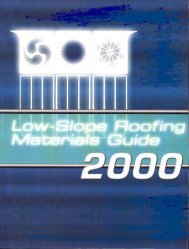


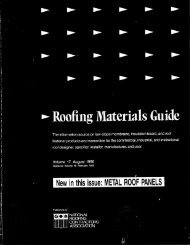
![Wm] - National Roofing Contractors Association](https://img.yumpu.com/36696816/1/190x245/wm-national-roofing-contractors-association.jpg?quality=85)


